  |
American Woodcock Migration Study December, 2019 Update |
|
|
December 17, 2019
NOTE: This is an update of January 22, 2019 American Woodcock Migration Study information; the July 31 update consists of the posting of the study report below:
During both the fall of 2018 and 2019, Fish and Wildlife worked cooperatively with several state/provincial, federal, university, and non-governmental agencies as part of the Eastern Woodcock Migration Research Cooperative. This study uses GPS telemetry units to better understand woodcock ecology stopover and migration.
Study objectives are to:
- Assess rate and path of migration during fall and spring;
- Compare migration strategies between northern and southern breeding populations of woodcock;
- Analyze landscape patterns affecting migratory stopover during migrations;
- Evaluate survival of GPS-marked woodcock during migration and relate to observed patterns in mortality associated with regional variation or landscape-scale factors;
- Combine telemetry data with other datasets to develop a full life cycle population model for American woodcock.
2018-19 Summary, New Jersey
During December 2018, 15 woodcock were telemetered on the lower Cape May peninsula. One bird was shot by a hunter on Higbee WMA in mid-December and in mid-February, one bird was found dead in a yard in Cape May near its banding location, presumably the victim of a vehicle collision. During winter 2019, 13 birds were still active wintering in Cape May County, NJ, eastern NC, eastern MD and eastern VA. By mid-March, 12 transmitters were active and initiated spring migration. By late April, these woodcock had moved to Nova Scotia, New Brunswick, Quebec, Ontario, Cape Cod, Massachusetts, Downeast Maine, northern New York, and Vermont (Figure 1).
2019 Field Season, New Jersey
During December 2019, 15 woodcock were again telemetered on the lower Cape May peninsula. The Nature Conservancy and Cape May National Wildlife Refuge played key cooperator roles by preparing (mowing) sites for capture in roost fields and allowing access to land. Woodcock were captured using a combination of mist nets and spotlighting with long-handled dip nets in mowed strips of fields.
Following the hunting season, this page will be periodically updated with maps showing movements of the birds marked in New Jersey through the winter/spring of 2020.
A full report from the 2018-19 field season is contained in the American Woodcock Migration Study Report, June 17, 2019 (pdf, 5.3mb)
|
Click images to enlarge
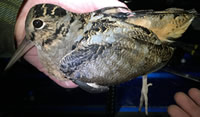
Woodcock with telemetry device.
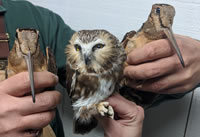
Bonus saw-whet owl (center) captured and banded by NJ Audubon cooperators on same night/site where several woodcock were instrumented.
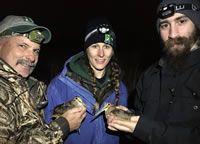
NJDFW capture crew (from left) Ted Nichols, Lisa Clark, and Jacob Goldman, with last two instrumented female specimens, 2019.
|
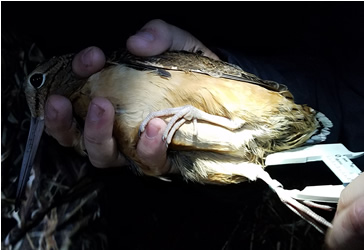
Division staff working by headlamp to collect body measurements before fitting with transmitter.
Click to enlarge
|
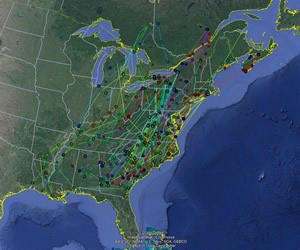 Locations and movements of woodcock marked as part of the Eastern Woodcock Migration Research Cooperative, December 2019.
Locations and movements of woodcock marked as part of the Eastern Woodcock Migration Research Cooperative, December 2019.
Click to enlarge
|
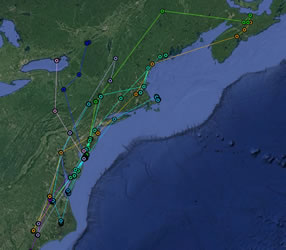
Figure 1. Map showing winter-spring 2019 movements of birds captured in New Jersey during December 2018. Each color represents a different bird.
Click to enlarge
|
|






